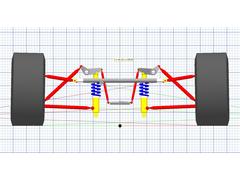FERRARIST
|
| posted on 31/7/13 at 06:22 PM |

|
|
Lower wishbone angle
Don't find any useful info and i need to ask here.
Building new front suspension from scratch, and while playing variables here http://www.racingaspirations.com
wondering is there a problem if lower wishbones mounting points on chassis is lower than mounting points on hub - let's say 4-6 degrees.
My subframe is much closer to the ground and it will be hassle to make higher mounting points.
Thanks.
|
|
|
|
|
rodgling
|
| posted on 31/7/13 at 07:16 PM |

|
|
Normally I think people aim to get the two pivot points (ball joint and wishbone pivots) level horizontally, maybe you could make an sort of offset
ball joint-onto-wishbone mounting arrangement which lowest the ball joint relative to the wishbone? Not sure if this is a good idea though...
edit: i mean level horizontally, as in same height off the floor, not vertically...
[Edited on 31/7/13 by rodgling]
|
|
|
big-vee-twin
|
| posted on 31/7/13 at 07:29 PM |

|
|
Level horizontally.
Sometimes lower wishbone points slightly down towards wheel depending how lower ball joint is mounted
Duratec Engine is fitted, MS2 Extra V3 is assembled and tested, engine running, car now built. IVA passed 26/02/2016
http://www.triangleltd.com
|
|
|
Theshed
|
| posted on 31/7/13 at 07:55 PM |

|
|
Mine do
 
Susprog suspension front
It all depends on your geometry and what you are trying to achieve. Attached pic is a screen shot from Susprog - I went for no movement of roll
centres and keeping the outside tyre vertical in roll. Will it work....... Dunno
|
|
|
britishtrident
|
| posted on 31/7/13 at 08:01 PM |

|
|
You have to plot the roll-centre under various suspension movement conditions, and also ball joint articulation.
Personally I would advise against, normally the outer ball joint should be very slightly lower than the inner pivots at least in the unladen
state.
General guidelines are
(1) Both front or rear static roll centre heights should not be below ground level.
(2) Both front or rear centre heights should be below the cg height.
(3) Both roll centre positions should not move too far in roll or bump suspension movement.
(4) Generally rule of thumb roll centres for sports and racing cars are between 0 and 150mm above the road.
(5) The line joining the the front and rear static roll centres is the roll axis governs the handling balance of the vehicle the slope of the
roll axis should be chosen to fit with weight distribution of the vehicle, ie heavy end of vehicle generally should have a higher roll centre than
the light end.
It may be that you have to reconsider your chosen you chosen tyre size and rim diameter.
[Edited on 31/7/13 by britishtrident]
[I] “ What use our work, Bennet, if we cannot care for those we love? .”
― From BBC TV/Amazon's Ripper Street.
[/I]
|
|
|
FERRARIST
|
| posted on 31/7/13 at 09:27 PM |

|
|
quote:
Originally posted by britishtrident
You have to plot the roll-centre under various suspension movement conditions, and also ball joint articulation.
Personally I would advise against, normally the outer ball joint should be very slightly lower than the inner pivots at least in the unladen
state.
General guidelines are
(1) Both front or rear static roll centre heights should not be below ground level.
(2) Both front or rear centre heights should be below the cg height.
(3) Both roll centre positions should not move too far in roll or bump suspension movement.
(4) Generally rule of thumb roll centres for sports and racing cars are between 0 and 150mm above the road.
(5) The line joining the the front and rear static roll centres is the roll axis governs the handling balance of the vehicle the slope of the
roll axis should be chosen to fit with weight distribution of the vehicle, ie heavy end of vehicle generally should have a higher roll centre than
the light end.
It may be that you have to reconsider your chosen you chosen tyre size and rim diameter.
[Edited on 31/7/13 by britishtrident]
Many thanks for being so specific, that's not a locost project, trying to build new front suspension for my mid engined Alfa 156.....it's
OE front setup is awful for track and tuning......now i have 48\52 front to rear weight balance, and it performs way better than before......all i
need is front suspension change......
Below is my "draft", please don't mind how it looks like, that's only some kind of try-out wishbones because it is really hard
to make one from first attempt - all wishbones and shock positions will be made again when correct dimensions taken........

[Edited on 31/7/13 by FERRARIST]
|
|
|













